The Administration of 4-Hexylresorcinol Accelerates Orthodontic Tooth Movement and Increases the Expression Level of Bone Turnover Markers in Ovariectomized Rats
Abstract
1. Introduction
2. Results
2.1. 4HR Application Increases Osteogenic Markers in Saos-2 Cells
2.2. Effects of 4HR on the Expression of Osteogenesis-Related Proteins in Saos-2 Cells
2.3. Application of 4HR Accelerates Tooth Movement
2.4. Plasma Level of Bone Turnover Markers
3. Discussion
4. Materials and Methods
4.1. Cellular Experiment and Western Blot
4.2. IP-HPLC
4.3. Animals and Experimental Design
4.4. Micro-Computerized Tomography and Histological Analysis
4.5. Western Blot for Tissue Samples
4.6. Statistical Analysis
5. Conclusions
Supplementary Materials
Author Contributions
Acknowledgments
Conflicts of Interest
Abbreviations
| AP | Alkaline phosphatase |
| BMP | Bone morphogenic protein |
| BMPR-II | Bone morphogenetic protein receptor-II |
| CaM | Calmodulin |
| CTGF | Connective tissue growth factor |
| ELISA | Enzyme-linked immunosorbent assay |
| ERβ | Estrogen receptor β |
| FGF-2 | Fibroblast growth factor-2 |
| 4HR | 4-Hexylresorcinol |
| IP-HPLC | Immunoprecipitation high-performance liquid chromatography |
| OC | Osteocalcin |
| OP | Osteopontin |
| Runx2 | Runt-related transcription factor 2 |
| TRACP | Tartrate-resistant acid phosphatase |
| TGF-β1 | Transforming growth factor-β1 |
| TGase-2 | Transglutaminase-2 |
References
- Masella, R.S.; Meister, M. Current concepts in the biology of orthodontic tooth movement. Am. J. Orthod. Dentofac. Orthop. 2006, 129, 458–468. [Google Scholar] [CrossRef]
- Proffit, W.R. The biologic basis of orthodontic therapy. In Contemporary Orthodontics, 6th ed.; Fields, H.W., Larson, B., Sarver, D.M., Eds.; Mosby: St Louis, IX, USA, 2013; Chapter 8; pp. 296–325. [Google Scholar]
- Kurol, J.; Owman-Moll, P. Hyalinization and root resorption during early orthodontic tooth movement in adolescents. Angle Orthod. 1998, 68, 161–165. [Google Scholar] [PubMed]
- Theodorou, C.I.; Kuijpers-Jagtman, A.M.; Bronkhorst, E.M. Optimal force magnitude for bodily orthodontic tooth movement with fixed appliance: A systematic review. Am. J. Orthod. Dentofac. Orthop. 2019, 156, 582–592. [Google Scholar] [CrossRef]
- Nishimura, M.; Chiba, M.; Ohashi, T.; Sato, M.; Shimizu, Y.; Igarashi, K.; Mitanig, H. Periodontal tissue activation by vibration: Intermittent stimulation by resonance vibration accelerates experimental tooth movement in rats. Am. J. Orthod. Dentofac. Orthop. 2008, 133, 572–583. [Google Scholar] [CrossRef]
- Iino, S.; Sakoda, S.; Ito, G.; Nishimori, T.; Ikeda, T.; Miyawaki, S. Acceleration of orthodontic tooth movement by alveolar corticotomy in the dog. Am. J. Orthod. Dentofac. Orthop. 2007, 131, 448.e1–448.e8. [Google Scholar] [CrossRef]
- Alfawal, A.M.H.; Hajeer, M.Y.; Ajaj, M.A.; Hamadah, O.; Brad, B. Effectiveness of minimally invasive surgical procedures in the acceleration of tooth movement: A systematic review and metaanalysis. Prog. Orthod. 2016, 17, 33. [Google Scholar] [CrossRef]
- Li, Y.; Chen, X.Y.; Tang, Z.L.; Tan, J.Q.; Wang, D.X.; Dong, Q. Differences in accelerated tooth movement promoted by recombinant human parathyroid hormone after mandibular ramus osteotomy. Am. J. Orthod. Dentofac. Orthop. 2019, 155, 670–680. [Google Scholar] [CrossRef] [PubMed]
- Bartzela, T.; Türp, J.C.; Motschall, E.; Maltha, J.C. Medication effects on the rate of orthodontic tooth movement: A systematic literature review. Am. J. Orthod. Dentofac. Orthop. 2009, 135, 16–26. [Google Scholar] [CrossRef] [PubMed]
- Drăgănescu, M.; Carmocan, C. Hormone therapy in breast cancer. Chirurgia 2017, 112, 413–417. [Google Scholar] [CrossRef]
- Kozubek, A.; Tyman, J.H.P. Resorcinolic lipids, the natural non-isoprenoid phenolic amphiphiles and their biological activity. Chem. Rev. 1999, 99, 1–25. [Google Scholar] [CrossRef]
- Farris, P.; Zeichner, J.; Berson, D. Efficacy and tolerability of a skin brightening/anti-aging cosmeceutical containing retinol 0.5%, niacinamide, hexylresorcinol, and resveratrol. J. Drugs Dermatol. 2016, 15, 863–868. [Google Scholar] [PubMed]
- Kweon, H.; Kim, S.G.; Choi, J.Y. Inhibition of foreign body giant cell formation by 4- hexylresorcinol through suppression of diacylglycerol kinase delta gene expression. Biomaterials 2014, 35, 8576–8584. [Google Scholar] [CrossRef] [PubMed]
- Song, J.Y.; Kim, S.G.; Park, N.R.; Choi, J.Y. Porcine bone incorporated with 4-hexylresorcinol increases new bone formation by suppression of the nuclear factor kappa B signaling pathway. J. Craniofac. Surg. 2018, 29, 1983–1990. [Google Scholar] [CrossRef] [PubMed]
- Lee, K.; Seo, I.; Choi, M.H.; Jeong, D. Roles of mitogen-activated protein kinases in osteoclast biology. Int. J. Mol. Sci. 2018, 19, 3004. [Google Scholar] [CrossRef]
- Sobacchi, C.; Menale, C.; Villa, A. The RANKL-RANK axis: A bone to thymus round trip. Front. Immunol. 2019, 10, 629. [Google Scholar] [CrossRef]
- Kim, S.G.; Hahn, B.D.; Park, D.S.; Lee, Y.C.; Choi, E.J.; Chae, W.S.; Baek, D.H.; Choi, J.Y. Aerosol deposition of hydroxyapatite and 4-hexylresorcinol coatings on titanium alloys for dental implants. J. Oral Maxillofac. Surg. 2011, 69, e354–e363. [Google Scholar] [CrossRef]
- Jo, Y.Y.; Kim, D.W.; Choi, J.Y.; Kim, S.G. 4-Hexylresorcinol and silk sericin increase the expression of vascular endothelial growth factor via different pathways. Sci. Rep. 2019, 9, 3448. [Google Scholar] [CrossRef]
- Kim, M.K.; Yoon, C.S.; Kim, S.G.; Park, Y.W.; Lee, S.S.; Lee, S.K. Effects of 4-hexylresorcinol on protein expressions in RAW 264.7 cells as determined by immunoprecipitation high performance liquid chromatography. Sci. Rep. 2019, 9, 3379. [Google Scholar] [CrossRef]
- Qin, Y.; Tang, S.; Zhen, G.; Ding, Q.; Ding, S.; Cao, X. Bone-targeted delivery of TGF-β type 1 receptor inhibitor rescues uncoupled bone remodeling in Camurati-Engelmann disease. Ann. N. Y. Acad. Sci. 2018, 1433, 29–40. [Google Scholar] [CrossRef]
- Bauss, F.; Wagner, M.; Hothorn, L.H. Total administered dose of ibandronate determines its effects on bone mass and architecture in ovariectomized aged rats. J. Rheumatol. 2002, 29, 990–998. [Google Scholar]
- Yeh, J.K.; Chen, M.M.; Aloia, J.F. Ovariectomy-induced high turnover in cortical bone is dependent on pituitary hormone in rats. Bone 1996, 18, 443–450. [Google Scholar] [CrossRef]
- Iglesias-Linares, A.; Morford, L.A.; Hartsfield, J.K., Jr. Bone density and dental external apical root resorption. Curr. Osteoporos. Rep. 2016, 14, 292–309. [Google Scholar] [CrossRef] [PubMed]
- Sirisoontorn, I.; Hotokezaka, H.; Hashimoto, M.; Gonzales, C.; Luppanapornlarp, S.; Darendeliler, M.A.; Yoshida, N. Tooth movement and root resorption; the effect of ovariectomy on orthodontic force application in rats. Angle Orthod. 2011, 81, 570–577. [Google Scholar] [CrossRef] [PubMed]
- Staderini, E.; Guglielmi, F.; Cornelis, M.A.; Cattaneo, P.M. Three-dimensional prediction of roots position through cone-beam computed tomography scans-digital model superimposition: A novel method. Orthod. Craniofac. Res. 2019, 22, 16–23. [Google Scholar] [CrossRef]
- Lee, K.M.; Kim, Y.I.; Park, S.B.; Son, W.S. Alveolar bone loss around lower incisors during surgical orthodontic treatment in mandibular prognathism. Angle Orthod. 2012, 82, 637–644. [Google Scholar] [CrossRef]
- Oz, A.Z.; Ciger, S. Health of periodontal tissues and resorption status after orthodontic treatment of impacted maxillary canines. Niger. J. Clin. Pract. 2018, 21, 301–305. [Google Scholar]
- Civitelli, R.; Armamento-Villareal, R.; Napoli, N. Bone turnover markers: Understanding their value in clinical trials and clinical practice. Osteoporos. Int. 2009, 20, 843–851. [Google Scholar] [CrossRef]
- Anesi, A.; Generali, L.; Sandoni, L.; Pozzi, S.; Grande, A. From osteoclast differentiation to osteonecrosis of the jaw: Molecular and clinical insights. Int. J. Mol. Sci. 2019, 20, 4925. [Google Scholar] [CrossRef]
- Bruderer, M.; Richards, R.G.; Alini, M.; Stoddart, M.J. Role and regulation of RUNX2 in osteogenesis. Eur. Cell. Mater. 2014, 28, 269–286. [Google Scholar] [CrossRef]
- Sinha, K.M.; Zhou, X. Genetic and molecular control of osterix in skeletal formation. J. Cell. Biochem. 2013, 114, 975–984. [Google Scholar] [CrossRef]
- Dodge, G.R.; Diaz, A.; Sanz-Rodriguez, C.; Reginato, A.M.; Jimenez, S.A. Effects of interferon-gamma and tumor necrosis factor alpha on the expression of the genes encoding aggrecan, biglycan, and decorin core proteins in cultured human chondrocytes. Arthritis Rheum. 1998, 41, 274–283. [Google Scholar] [CrossRef]
- Choi, Y.H.; Choi, J.H.; Oh, J.W.; Lee, K.Y. Calmodulin-dependent kinase II regulates osteoblast differentiation through regulation of osterix. Biochem. Biophys. Res. Commun. 2013, 432, 248–255. [Google Scholar] [CrossRef] [PubMed]
- Kokabu, S.; Rosen, V. BMP3 expression by osteoblast lineage cells is regulated by canonical Wnt signaling. FEBS Open. Biol. 2017, 8, 168–176. [Google Scholar] [CrossRef] [PubMed]
- Kenkre, J.S.; Bassett, J. The bone remodelling cycle. Ann. Clin. Biochem. 2018, 55, 308–327. [Google Scholar] [CrossRef]
- Mizokami, A.; Kawakubo-Yasukochi, T.; Hirata, M. Osteocalcin and its endocrine functions. Biochem. Pharmacol. 2017, 132, 1–8. [Google Scholar] [CrossRef]
- Singh, A.; Gill, G.; Kaur, H.; Amhmed, M.; Jakhu, H. Role of osteopontin in bone remodeling and orthodontic tooth movement: A review. Prog. Orthod. 2018, 19, 18. [Google Scholar] [CrossRef]
- Jung, H.M.; Lee, J.E.; Lee, S.J.; Lee, J.T.; Kwon, T.Y.; Kwon, T.G. Development of an experimental model for radiation-induced inhibition of cranial bone regeneration. Maxillofac. Plast. Reconstr. Surg. 2018, 40, 34. [Google Scholar] [CrossRef]
- Weisz, J.; Gunsalus, P. Estrogen levels in immature female rats: True or spurious—Ovarian or adrenal? Endocrinology 1973, 93, 1057–1065. [Google Scholar] [CrossRef]
- Yoon, K.H.; Cho, D.C.; Yu, S.H.; Kim, K.T.; Jeon, Y.; Sung, J.K. The change of bone metabolism in ovariectomized rats: Analyses of microCT scan and biochemical markers of bone turnover. J. Korean Neurosurg. Soc. 2012, 51, 323–327. [Google Scholar] [CrossRef]
- Ueta, M.; Takaoka, K.; Yamamura, M.; Maeda, H.; Tamaoka, J.; Nakano, Y.; Noguchi, K.; Kishimoto, H. Effects of TGF-β1 on the migration and morphology of RAW264.7 cells in vitro. Mol. Med. Rep. 2019, 20, 4331–4339. [Google Scholar] [CrossRef]
- Salazar, M.; Hernandes, L.; Ramos, A.L.; Micheletti, K.R.; Albino, C.C.; Nakamura Cuman, R.K. Effect of teriparatide on induced tooth displacement in ovariectomized rats: A histomorphometric analysis. Am. J. Orthod. Dentofacial. Orthop. 2011, 139, e337–e344. [Google Scholar] [CrossRef] [PubMed]
- Farris, E.J. Breeding of the rat. In The Rat in Laboratory Investigation, 2nd ed.; Griffith, J.Q., Farris, E.J., Hafner, J.B., Eds.; Lippincott Company: Philadelphia, NY, USA, 1963; pp. 1–18. [Google Scholar]
- Seo, M.H.; Myoung, H.; Lee, J.H.; Kim, S.M.; Lee, S.K. Changes in oncogenic protein levels in peri-implant oral malignancy: A case report. Maxillofac. Plast. Reconstr. Surg. 2019, 41, 46. [Google Scholar] [CrossRef] [PubMed]
- Yoon, C.S.; Kim, M.K.; Kim, Y.S.; Lee, S.K. In vivo protein expression changes in mouse livers treated with dialyzed coffee extract as determined by IP-HPLC. Maxillofac. Plast. Reconstr. Surg. 2018, 40, 44. [Google Scholar] [CrossRef] [PubMed]
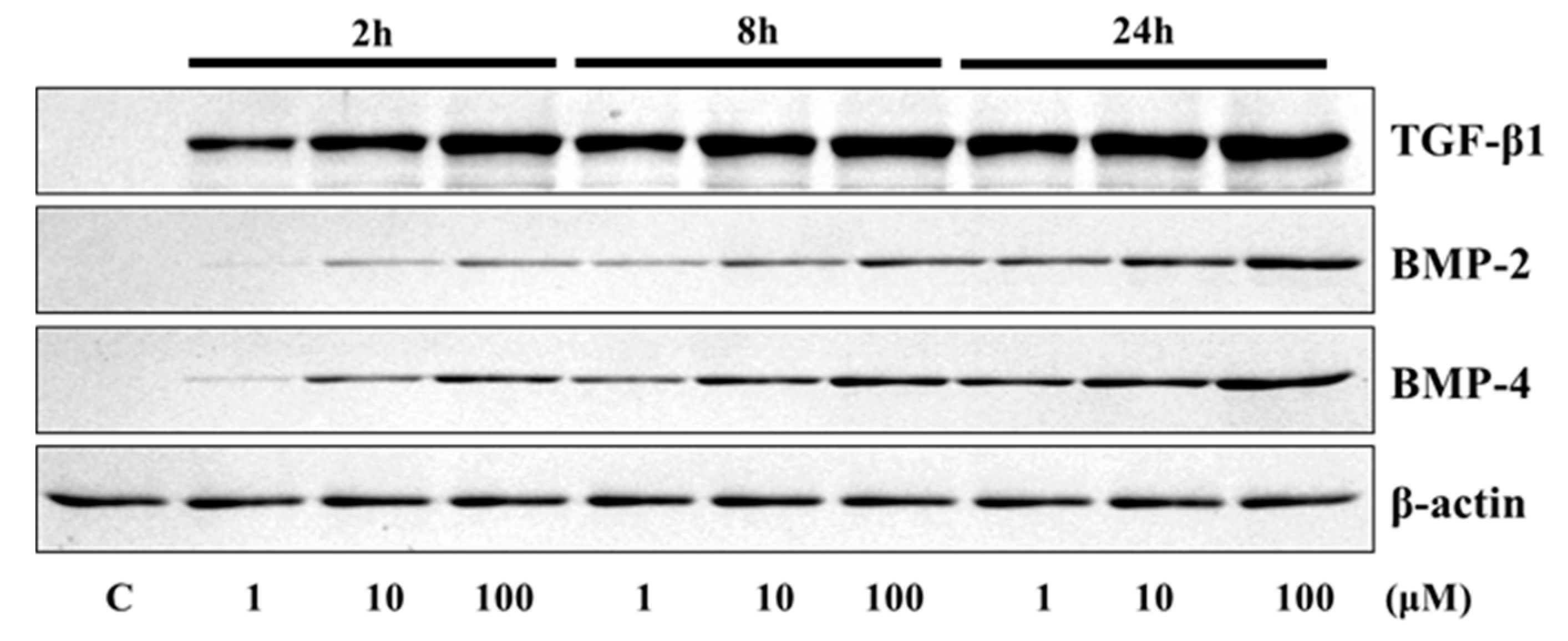
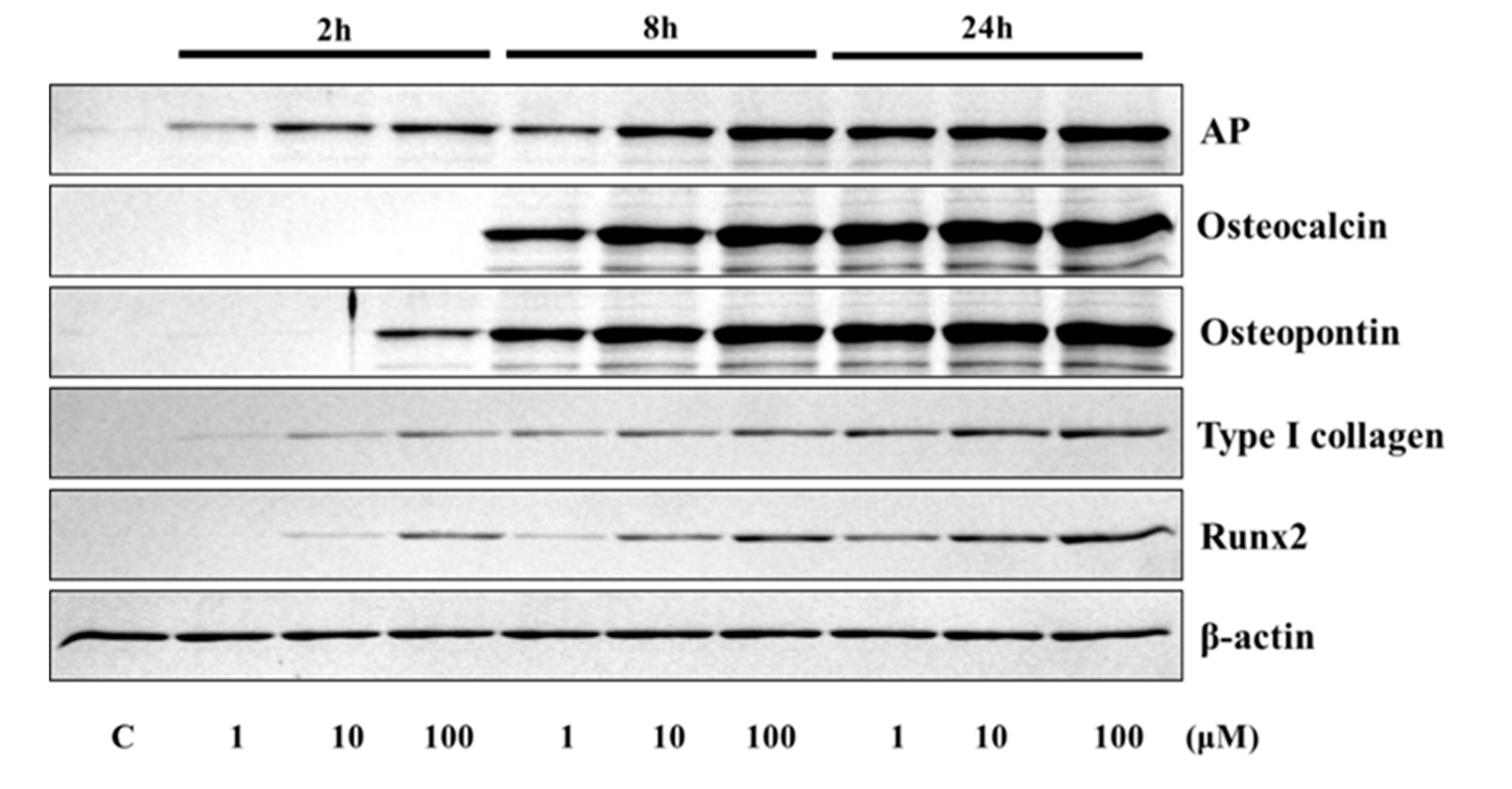

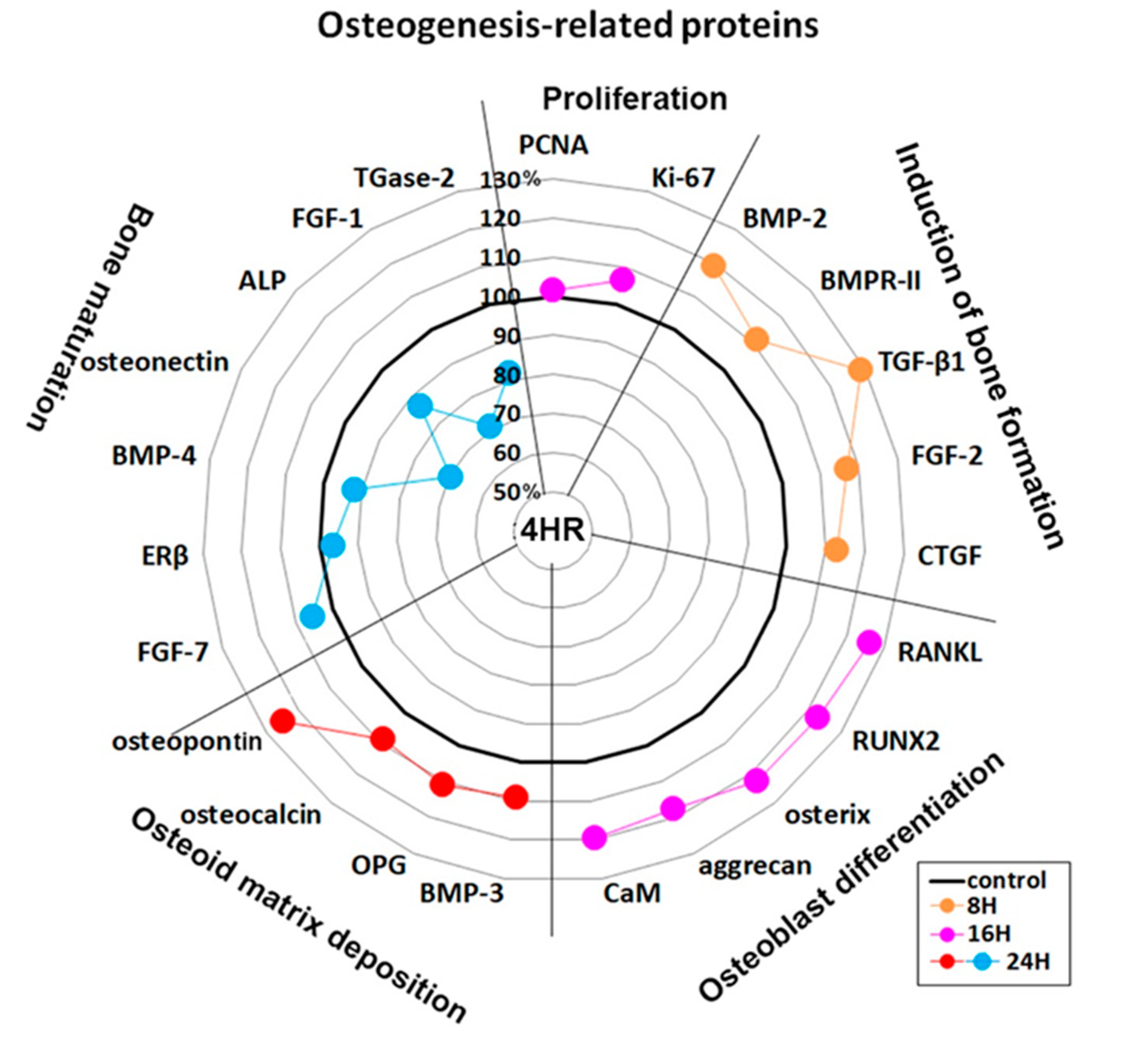
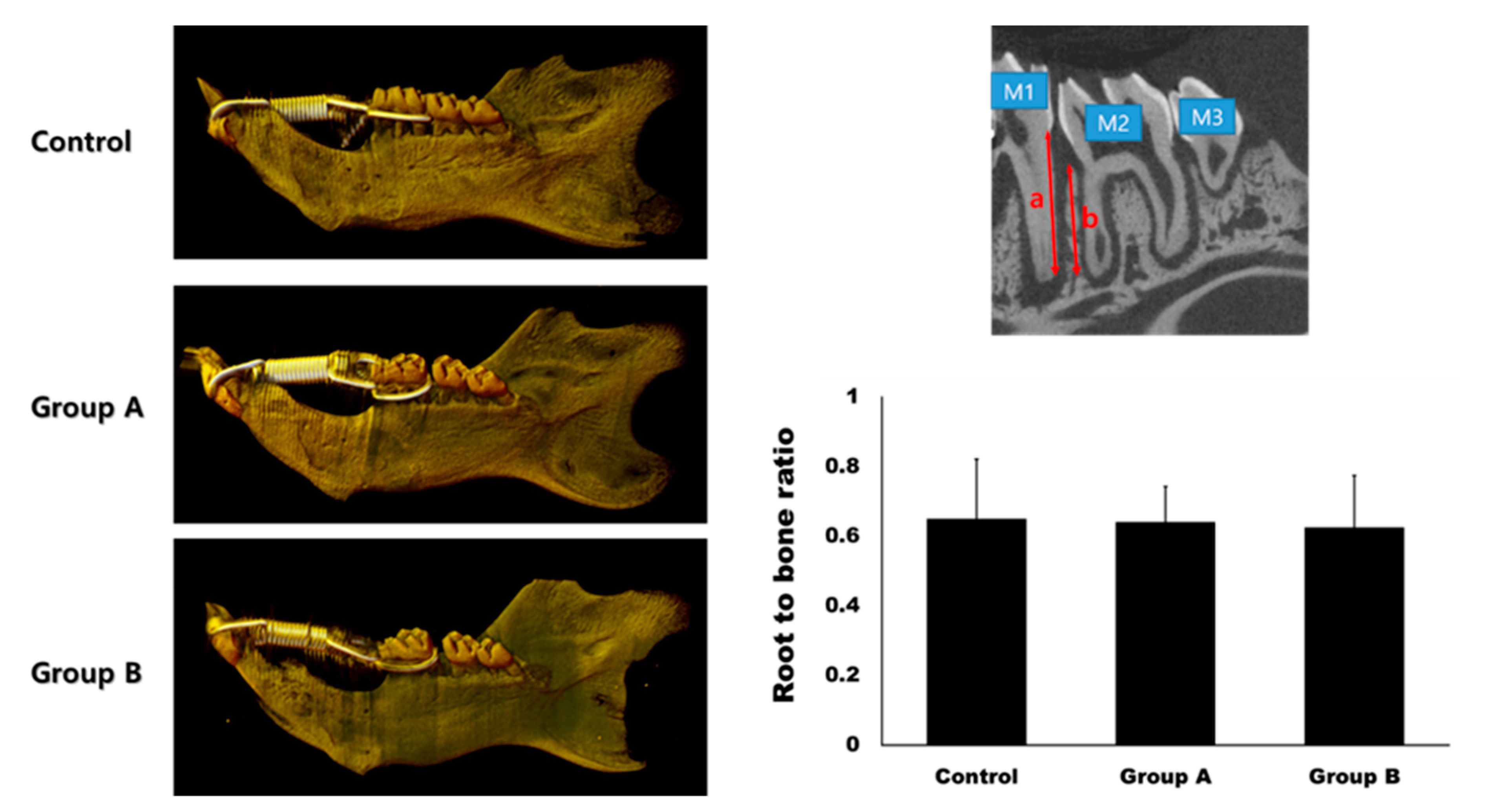
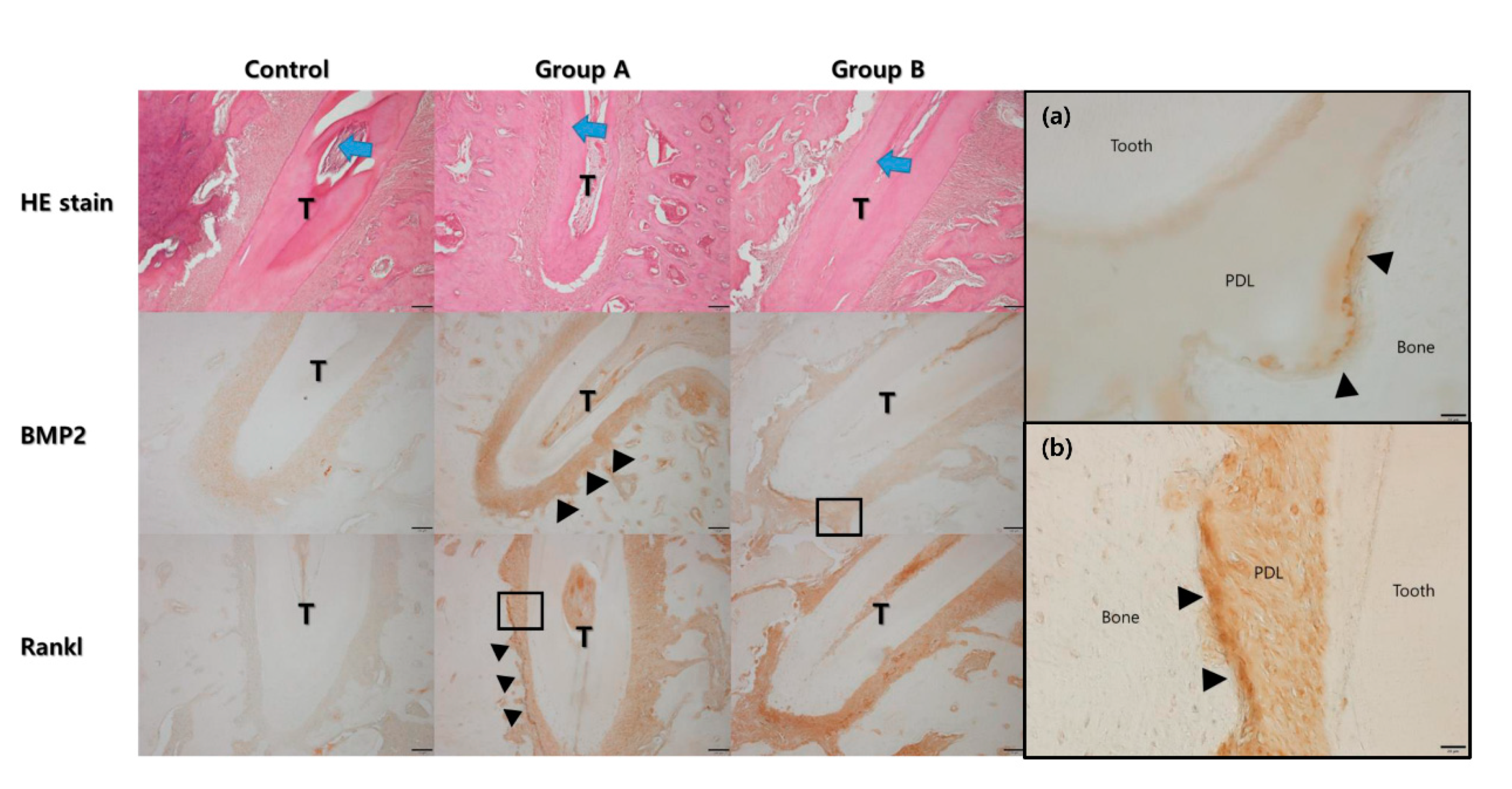
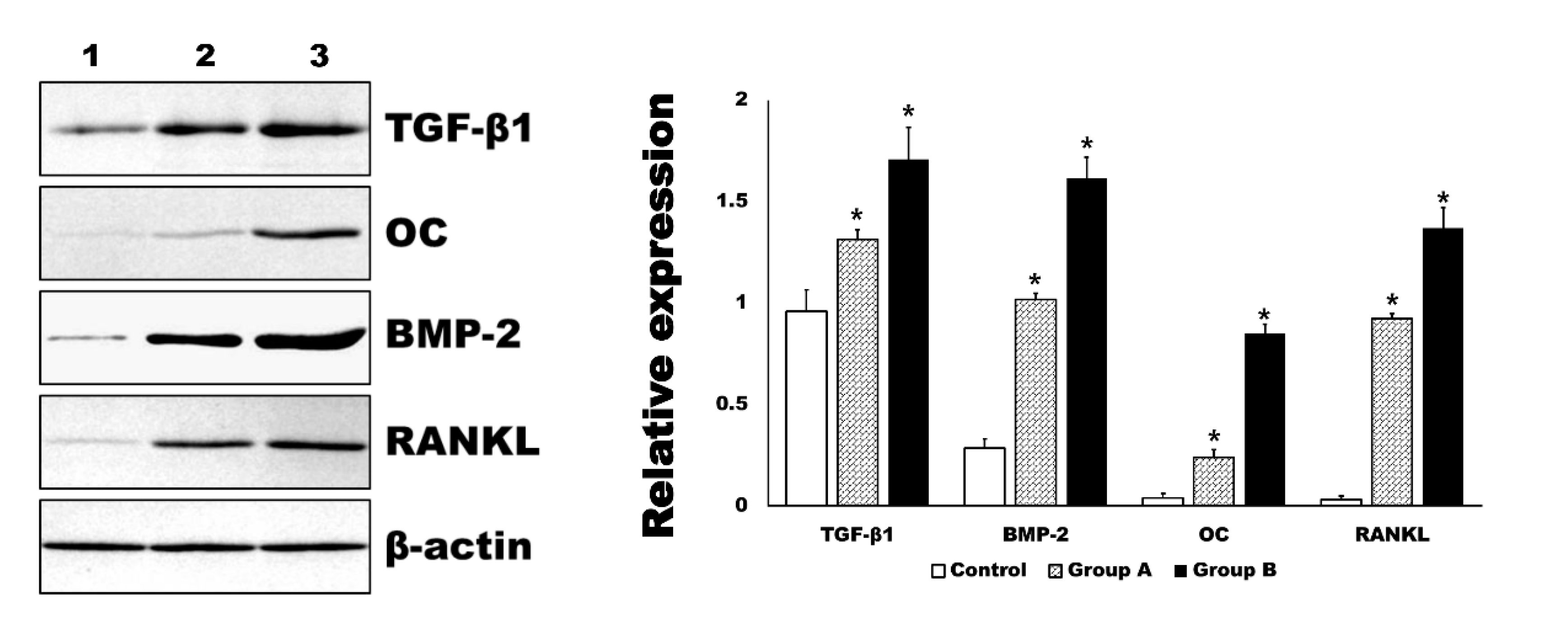
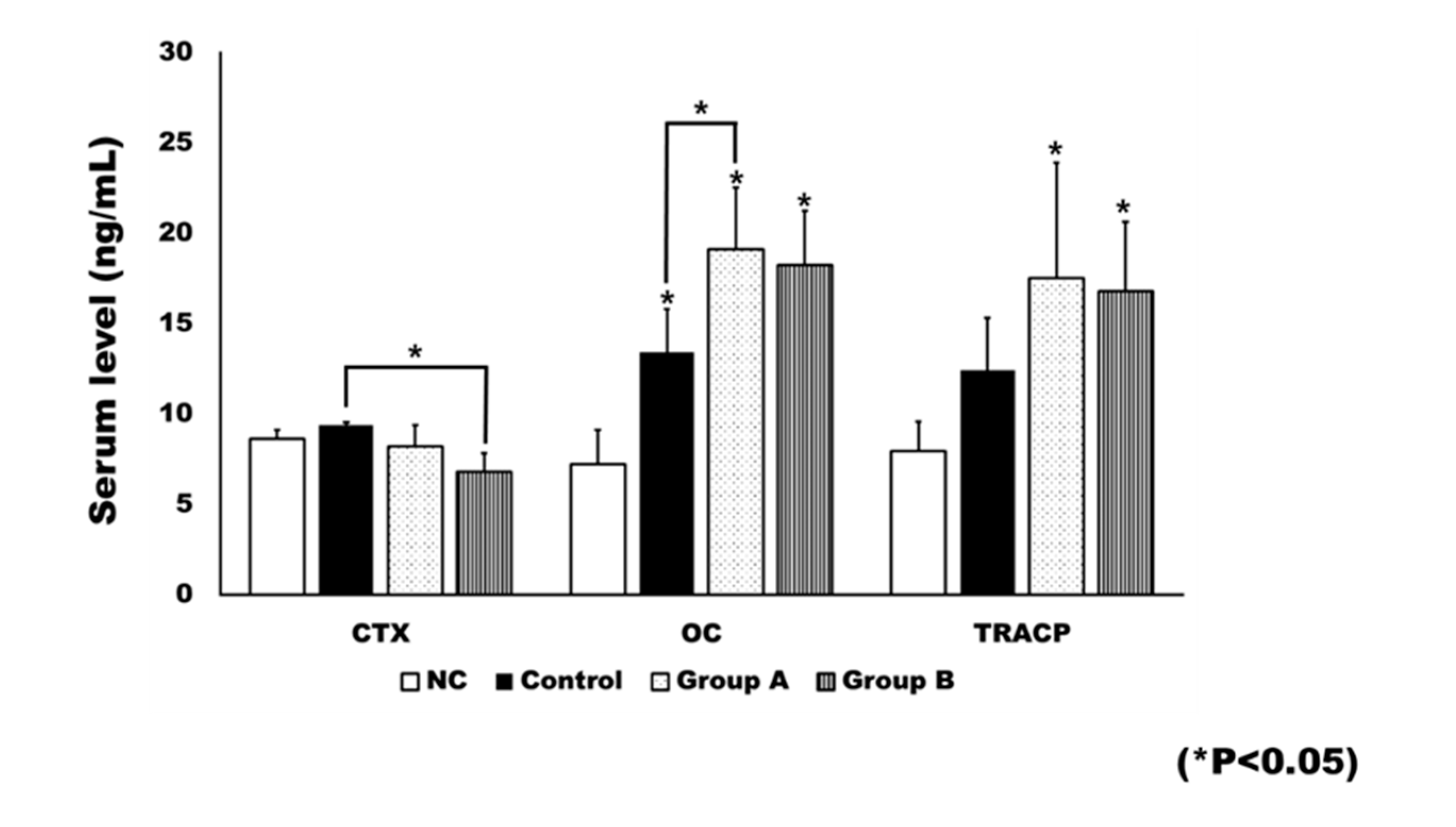

| Group | Day 7 | Day 14 |
|---|---|---|
| Control group | 0.24 ± 0.84 mm | 1.98 ± 1.12 mm |
| Experimental Group A | 0.92 ± 1.00 mm | 2.63 ± 0.68 mm |
| Experimental Group B | 0.89 ± 0.61 mm | 2.90 ± 0.42 mm * |
© 2020 by the authors. Licensee MDPI, Basel, Switzerland. This article is an open access article distributed under the terms and conditions of the Creative Commons Attribution (CC BY) license (http://creativecommons.org/licenses/by/4.0/).
Share and Cite
Choi, K.-H.; Kim, D.-W.; Lee, S.K.; Kim, S.-G.; Kim, T.-W. The Administration of 4-Hexylresorcinol Accelerates Orthodontic Tooth Movement and Increases the Expression Level of Bone Turnover Markers in Ovariectomized Rats. Int. J. Mol. Sci. 2020, 21, 1526. https://doi.org/10.3390/ijms21041526
Choi K-H, Kim D-W, Lee SK, Kim S-G, Kim T-W. The Administration of 4-Hexylresorcinol Accelerates Orthodontic Tooth Movement and Increases the Expression Level of Bone Turnover Markers in Ovariectomized Rats. International Journal of Molecular Sciences. 2020; 21(4):1526. https://doi.org/10.3390/ijms21041526
Chicago/Turabian StyleChoi, Kwang-Hyo, Dae-Won Kim, Suk Keun Lee, Seong-Gon Kim, and Tae-Woo Kim. 2020. "The Administration of 4-Hexylresorcinol Accelerates Orthodontic Tooth Movement and Increases the Expression Level of Bone Turnover Markers in Ovariectomized Rats" International Journal of Molecular Sciences 21, no. 4: 1526. https://doi.org/10.3390/ijms21041526
APA StyleChoi, K.-H., Kim, D.-W., Lee, S. K., Kim, S.-G., & Kim, T.-W. (2020). The Administration of 4-Hexylresorcinol Accelerates Orthodontic Tooth Movement and Increases the Expression Level of Bone Turnover Markers in Ovariectomized Rats. International Journal of Molecular Sciences, 21(4), 1526. https://doi.org/10.3390/ijms21041526






